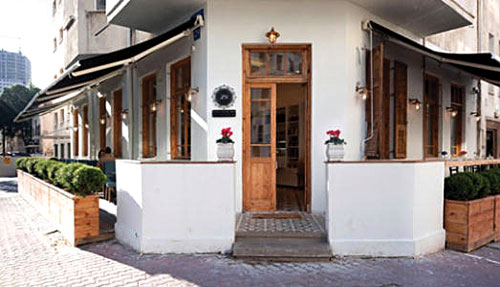.jpg)
.jpg)
Despite its secular nature and in contrast to much of what Orthodox Jews define as Israel, Tel Aviv is a breath of fresh air. Its vibrancy, dynamism, and futuristic vibe always make me feel alive and optimistic about Israel’s long term stability and growth. Its modern Jewish history and the growing and evolving touches of Judaism add to its flavor, making it a surprisingly inspirational place. Tourists should enjoy its pleasures, wander its streets and find meaning in the mundane.
.jpg)
In the Rothschild Boulevard area, the buildings are exquisite, built in the late 1920’s and early 1930s in Bauhaus style. Their amazing architectural details and history, spruced up by investors, make the neighborhood an aesthetic delight. The Alma Hotel is just one of a handful of new boutique hotels in the area offering charm and style second only to the Marais in Paris or downtown New York. Restaurateurs Adi and Irit Strauss took turned a six-family apartment house built in 1925 into a 15-room hotel, each suite unique in its bohemian style and designed by Shaltiel Kastiel with mosaic and glass artist Lauri Recanati. You can’t help but admire the attention paid to create a structure that honors the past while looking forward.
And just when you thought that you were in a totally secular area, you discover Bakery 29 right across the street. Former Wall Street manager Neta Korin founded the bakery/restaurant after retiring from Wall Street.. It’s kosher, delicious, stylish, and 100% of the profits go to Impact!, an organization that grants college tuition scholarships to combat soldiers.
Around the corner is the Great Synagogue and Independence Hall, located in the first house built in Tel Aviv in 1911. It that place, Ben Gurion announced the establishment of the State of Israel, and you can imagine people dancing the Hora in the streets on May 14, 1948, and realize that that is where you are standing, traffic and all—in the dream of the past realized.
Neve Tzedek and the Tachana are hip, expensive. They are great renditions of European “downtown” areas. Artists, tourists and nouveau rich sit in cafes and reconstructed apartments while street performers entertain the tourists at the old train depot. It’s hard to believe that Israel’s enemies have missiles pointing at Tel Aviv when thousands are biking, relaxing in coffee shops and just seizing life by the horns.
Playgrounds on the beachfront have amazing “toys” and things for the kids to enjoy and views are juxtaposed on the IDF museum across the street. The manmade and natural beauty of this Tel Aviv area serves as a witness to the natural desire of Israelis to live in peace, beautifully, in the Land of Israel.
Further up the shore, you’ll find another lively part of town, the Namal, the Northern Tel Aviv port that has been gentrified in the past ten years and turned into a dining and shopping haven. Bread and Wine is a fine kosher restaurant at the port, sharing the “kosher” list with Uno, Meatos, Lilith, Pasha… all great places to dine. And while enjoying the sound of the waves pounding against the rocks, the sounds of F 16’s roar overhead on their way to the neighboring Sde Dov landing field. Once they’re down, soldiers deplane, change their clothes and head over to the Namal to eat, dance, and live—despite the threats—as Israelis have learned to do.
By Jordana Schoor










